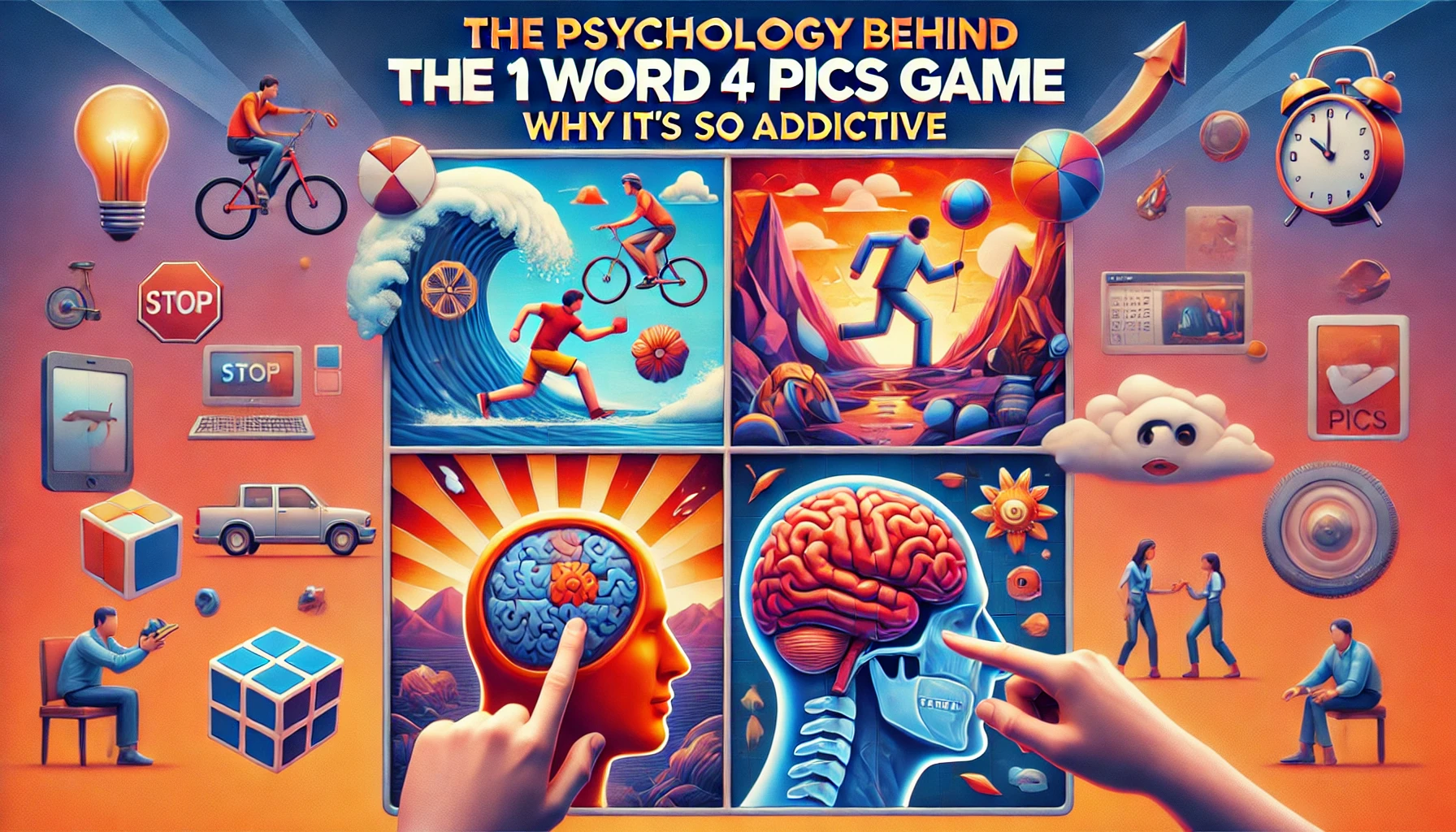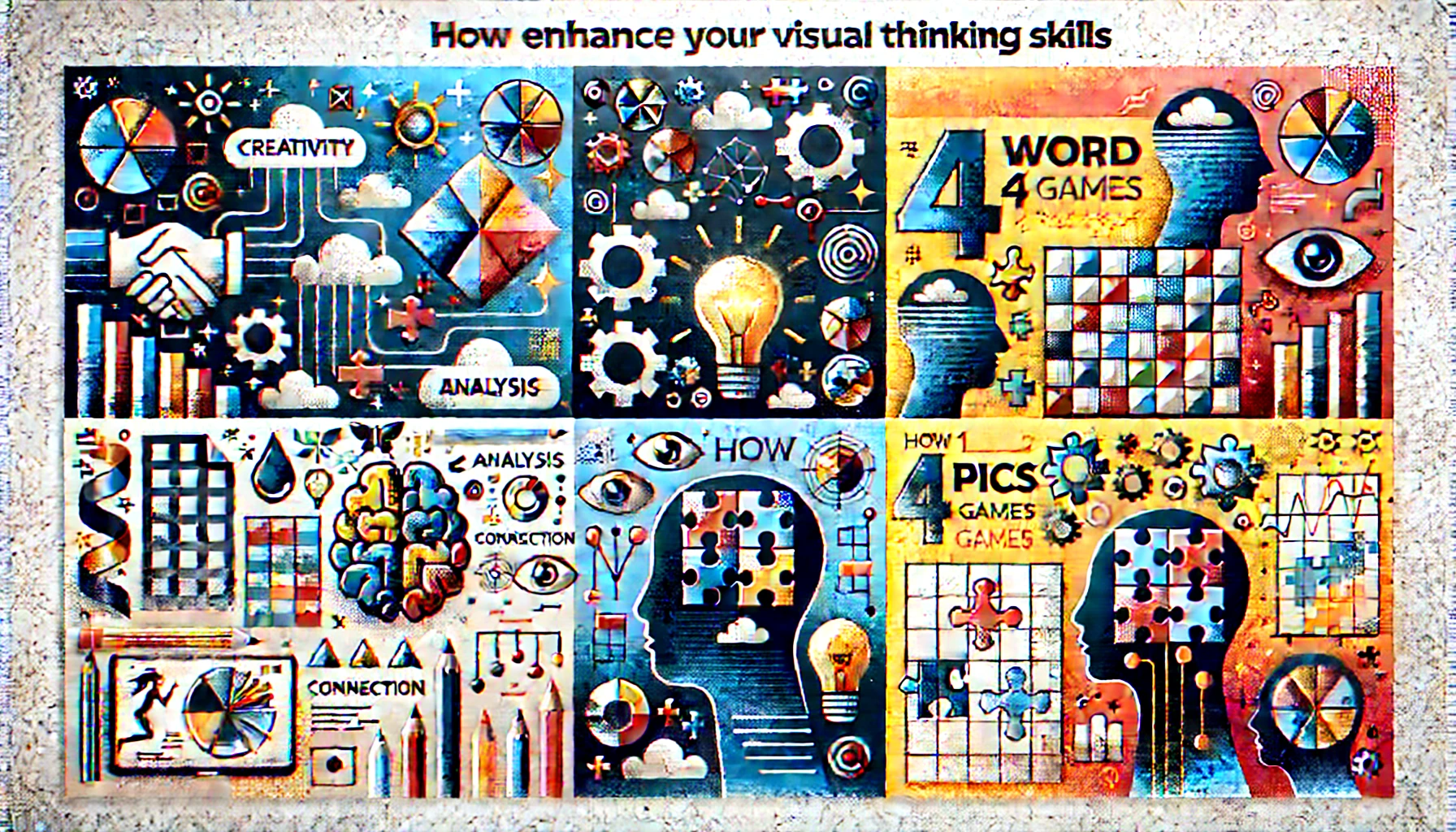Now Reading: The Psychology Behind the 1 Word 4 Pics Game: Why It’s So Addictive
- 01
The Psychology Behind the 1 Word 4 Pics Game: Why It’s So Addictive
The Psychology Behind the 1 Word 4 Pics Game: Why It’s So Addictive

Nowadays, most games and mobile apps allow us to spend a lot of time on them. The popular game which has rocked the world is the 1 Word 4 Pics game. They are shown four images that do not appear to have anything in common, and the player tries to guess the one word that ties all of them together. This game, which looks so simple, has become an addiction to millions of people, with people spending hours actively addicted. Why is it so addictive, however? The clue is in the psychology of the game that significantly appeals to the human processes of cognition, emotions and behaviour.
We are going to explore together, in this blog post, why this game is so difficult to resist, what the psychological factors behind it are, and even give a few useful 4 Pic One Word answers to the most complicated problems.
What Is the 1 Word 4 Pics Game?
It is necessary to get acquainted with the rules of the game before delving into the reasons why it is addictive. In the game of 4 Pics 1 Word (also called Four Pic One Word), there are four pictures so that players can receive them, and they have to come up with a single word that can be related to all four images. The pictures are usually not easy to connect, thus making the puzzle interesting and complicated.
As an example, there could be a picture of a beach, a sun, a hat, and a pair of sunglasses. Their commonality term may be the word summer.
The concept of the game is straightforward, but as the player advances through each level, the pictures become more complicated, and this makes the game an enjoyable struggle. The game should be played in short or long times, and this is why it fits all categories of players.
The Cognitive Appeal: Engaging Problem-Solving
The human brain is fond of puzzles. Something like crosswords, to Sudoku, we are instinctively geared towards finding problems to solve, which challenge our thinking ability. The game of 1 Word 4 Pics offers a humdrum, yet enthralling mental exercise.
Pattern Recognition
Pattern recognition is one of the most important psychological factors involved in the game. Human brains are extremely efficient in discovering patterns even where it is not easily noticeable. In the game, players have to identify the connections between four apparently unrelated pictures through the use of one word. This is the utilisation of our power to perceive relations among objects, which we have acquired during our evolutionary process.
As you go on in the levels, the puzzles become increasingly difficult, and you have to bend your brains to go farther and see the connection. This ever-evolving challenge keeps the brain active and involved to give a sense of achievement when you eventually succeed in cracking the code.
Cognitive Ease
The occurrence of cognitive ease will not only make a problem to appear effortless when it happens. The four pic one word answers tend to use basic ideas which are in our day-to-day lives. Since the game is cleverly made to be natural, the answers do not have to be overthought by the player, yet it does not feel like cheating (i.e. easy). This is the ideal measure of challenge and convenience since it gives sufficient satisfaction to the player without overburdening them.
Reward System:
Dopamine of Surprises Players, as they correctly guess the answer, have a little reward in the form of a dose of dopamine, a feel-good chemical in the brain. Enjoyable activities are enhanced by dopamine, which encourages one to do it again. The more that the player does this successfully, the more they are rewarded with a dopamine hit, which makes the player keep engaging in the behaviour. The game also incorporates repetitive rewards: some additional coins, a hint or a new level opening. Such rewards activate an area of the brain involved in reward, which leaves players addicted to the next challenge. This reward mechanism and the expectation to find the next puzzle are the main enablers of the addictive effect of the game.
Emotional Engagement: The Joy of Mastery
Although the game is based mainly on cognitive challenges, there is also a significant role of emotional involvement in terms of addictiveness. People are emotional creatures, and games such as the one-word four pics do stimulate our urge to be a master.
The sense of Achievement
The feeling of Achievement which the game can provide to the players is one of the most fulfilling points of the game. When you are able to additionally answer some questions correctly, you begin to feel you are getting better, you are becoming increasingly effective in your thinking out of the box, and you are getting to be a master of the game. This sense of control forms a positive feedback loop where the more one plays, the more one accomplishes, they feel.
Disappointment and release
The inability to resolve a puzzle is another emotional issue of the game, and one may get frustrated. Although it might sound surprising, frustration is a great contributor to the addictiveness of the game. Such a strong emotional payout is the relief and satisfaction felt when a hard puzzle has been solved, after a period of struggling with it. The alternation of unhappy surprise and happy surprise is a great incentive to play further.
Players may feel a lack of desire to stay on one puzzle long, and after a challenging one, in particular. This is the emotional roller coaster you know, when it starts good and you think you might have a winner, and then when you get frustrated because it finally goes bad, the roller coaster goes up the hill and down into the valley. This is what keeps the players coming back to play more and more.
Social Influence: Competing and Sharing
People are social animals, and the game appeals to the social aspect in us. No matter whether one is competing against friends, sharing their achievement or searching online for the four pic one word answers, the game contains some social elements that make it more exciting.
Competition and leaderboards
A leaderboard that indicates the fastest players or the level grinders is common in many versions of the game. This targets our inbuilt competitiveness. The game also gives us a practical gauge of where we stand with respect to other players, and so we are more motivated to play more to elevate our position in the rankings.
Sharing Solutions
There may be cases when a player may be at a dead end and require assistance in resolving a puzzle. Lots of players resort to online forums or social media and find just the hints for 4 Pic 1 Word answers in the game itself. The feeling of community creates another aspect of interactivity, where other players exchange tips, solutions and feelings of achievement.
The Role of Progression: Unlocking New Challenges
The fact that the game has new challenges all the time is one of the reasons why it is very addictive. The players will continue to see new kinds of puzzles as they progress through the game, and the degree of the abstractness of the interrelation between the images will tend to increase.
Keeping Things Fresh
The game designers are very much aware that boredom might easily reign if people fail to find a challenge in the game. That is why the game involved several stages and increasingly challenging puzzles. By the time the players move to the next image, they are exposed to more complicated images to maintain the pulse of the game, making it unexpected.
Such a feeling of advancement is important in retaining players. It is no different than the people enjoy when they level up in their favourite role-playing game or reach the next season of the show they like: it is the joy of progressing, unlocking something new, and reaching new milestones.

How the 1 Word 4 Pics Game Taps Into Habit Formation?
The game is made such that it will promote the development of habits. In psychology, forming a habit is associated with repetition and reward, which is embedded in the game.
Triggering the Habit Loop
The habit loop is made up of three aspects: the cue, the behaviour and the reward. In this game, the cue could be you seeing the app icon on your phone or you thinking about how fun the game is. Of course, the behaviour is playing the game. And the payoff is appearing in a puzzle, the dopamine solvent, and the emotional satisfaction of beating the game by its own rules.
Habit Reinforcement
Whenever you complete a puzzle, the routine loop is strengthened. The more you play, that is, the more patterns and puzzles you recognise, and the quicker you solve them and feel that great feeling of having accomplished something. The loop gets reinforced with time, and people find it very difficult to lay the game aside. Playing the game turns out to be a habit where players desire to play the game automatically in the end.
Why People Can’t Stop Playing?
As it turned out, the addictive quality of the game named 1 Word 4 Pics is reduced to the overall combination of cognitive engagement, emotions, social rivalry, and habit formation. These components can collaborate to produce a dynamic immersive experience that makes gamers want to replay it more often.
It is simple and thus gets one to play the game, and at the same time, the complex puzzles make it interesting. The reduced dopamine levels are then compensated by what can be described as the emotional highs of cracking a difficult puzzle and the dopamine rewards to such an extent that it spurs repeat playing. And when we add the social components to the game, competition and sharing solutions, the game is no longer fun for one person.
Conclusion
The 1 Word 4 Pics game is based on numerous cognitive principles, and that is why it isn’t easy to overcome. The game appeals to all types of people, whether in solving the problem and the euphoric feeling it entails when the pattern is recognised.
It could be said that the format of the game is simple, but addictive, and regardless of whether a person is trying to pass the time or is willing to push the brain to the limit, this might have been one of the effective methods that allowed it to bring entertainment to millions.
This is quite understandable, as we have already discovered that a combination of cognitive stimulation, emotional reward system, socialisation and formation of habits makes this game one of the most addictive ones. Then, the last time you get stumped by a difficult stage, keep in mind: your brain is not the only one putting in the effort; it is science!
What can I do with challenging puzzles in the game?
When you are not getting anywhere, then try to see if there is a similar theme in the pictures, such as an animal, nature, or season category. Exploit clues when they appear, and go to the web to find four pic one word answers.
Why is the game so addictive?
The game exploits our problem-solving tendencies, offers us emotional satisfaction, and employs practice in appealing to the mind of the gamers.
Is it possible to play the game without money?
Yes, the game is free to play with most versions. Hints or additional levels can be bought inside the game, but they are not needed to play the game.
What is the number of levels of the game?
The number of levels differs with the various versions; however, the traditional number of levels is commonly hundreds of levels, which gradually become harder.









